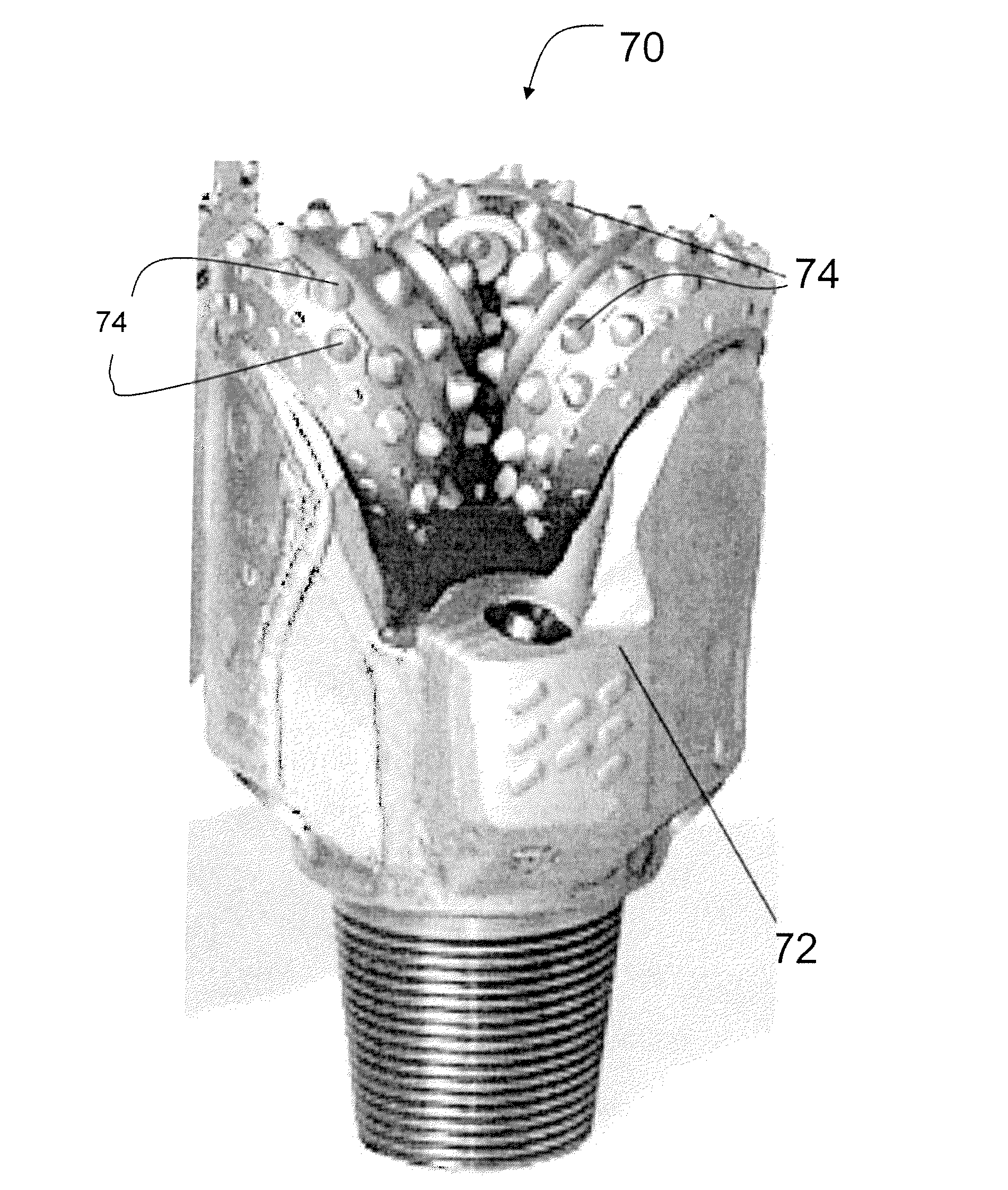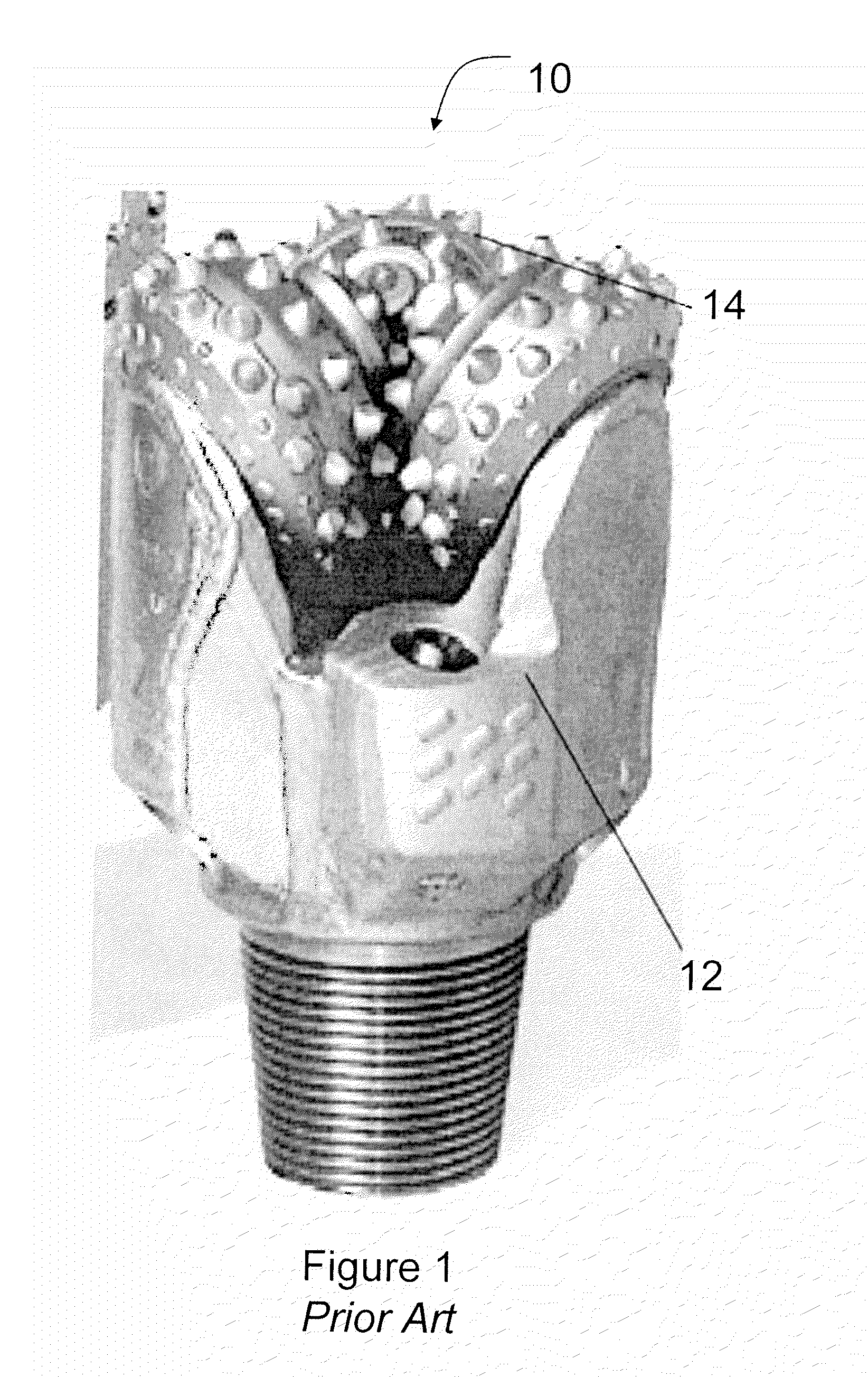Cutting inserts for earth-boring bits
a technology for cutting inserts and earth-boring bits, applied in the direction of cutting machines, drill bits, earth-moving drilling and mining, etc., can solve the problems of wc-co inserts suffering from premature abrasion and wear, increased toughness generally accompanied, and decreased wear resistan
- Summary
- Abstract
- Description
- Claims
- Application Information
AI Technical Summary
Benefits of technology
Problems solved by technology
Method used
Image
Examples
example 1
[0056]The microstructure of a non-limiting embodiment of a sintered cemented carbide material according to the present disclosure is shown in the photomicrograph of FIG. 8. The cemented carbide material shown in FIG. 8 was prepared by forming a powder blend consisting of, in percent by weight, 75% WC powder, 8% TiC powder, 5% TaC powder, 5% NbC powder, and 7% Co powder. The blended powder was consolidated into a green compact. The green compact was sintered at 1420° C.
[0057]The cemented carbide shown in the micrograph of FIG. 8 exhibits grains of tungsten carbide, and rounded grains comprising titanium carbide, tantalum carbide, niobium carbide, and their solid solutions. It is anticipated that the presence of the rounded grains comprising cubic carbides will improve the wear resistance of cutting inserts for earth-boring bits, while not substantially affecting certain other important properties of the cutting inserts, thereby extending the service life of the cutting inserts.
example 2
[0058]The microstructure of a non-limiting embodiment of a sintered cemented carbide material according to the present disclosure is shown in the photomicrograph of FIG. 9. The cemented carbide material shown in FIG. 9 was prepared by forming a powder blend consisting of, in percent by weight, 50% WC powder, 22% TaC powder, 20% NbC powder and 8% Co powder. The blended powder was consolidated into a green compact. The green compact was sintered at 1420° C.
[0059]The cemented carbide in the micrograph of FIG. 9 exhibits grains of tungsten carbide, and rounded grains comprising tantalum carbide, niobium carbide, and their solid solutions. It is anticipated that the presence of the rounded grains comprising cubic carbides will improve the wear resistance of cutting inserts for earth-boring bits, while not substantially affecting certain other important properties of the cutting inserts, thereby extending the service life of the cutting inserts.
example 3
[0060]The microstructure of a non-limiting embodiment of a sintered hybrid cemented carbide material according to the present disclosure is shown in the photomicrograph of FIG. 10. Two separate metallurgical powder blends were prepared. The first metallurgical powder blend, used for the continuous, second cemented carbide region, was prepared by forming a powder blend consisting of, in percent by weight, 50% WC powder, 22% TaC powder, 20% NbC powder, and 8% Co powder. A second metallurgical powder blend to be used for the plurality of first cemented carbide regions, or dispersed phase, was prepared by blending, in percent by weight, 90% of WC powder and 10% of Co powder. In percent by weight, 85% of the first metallurgical powder blend was mixed with 15% of the second metallurgical powder blend. The mixed powder was consolidated and sintered at 1420° C. to form a sintered hybrid cemented carbide material.
[0061]In the non-limiting embodiment of FIG. 10, a hybrid cemented carbide mate...
PUM
| Property | Measurement | Unit |
|---|---|---|
| grain size | aaaaa | aaaaa |
| temperatures | aaaaa | aaaaa |
| weight percent | aaaaa | aaaaa |
Abstract
Description
Claims
Application Information
 Login to View More
Login to View More - R&D
- Intellectual Property
- Life Sciences
- Materials
- Tech Scout
- Unparalleled Data Quality
- Higher Quality Content
- 60% Fewer Hallucinations
Browse by: Latest US Patents, China's latest patents, Technical Efficacy Thesaurus, Application Domain, Technology Topic, Popular Technical Reports.
© 2025 PatSnap. All rights reserved.Legal|Privacy policy|Modern Slavery Act Transparency Statement|Sitemap|About US| Contact US: help@patsnap.com



